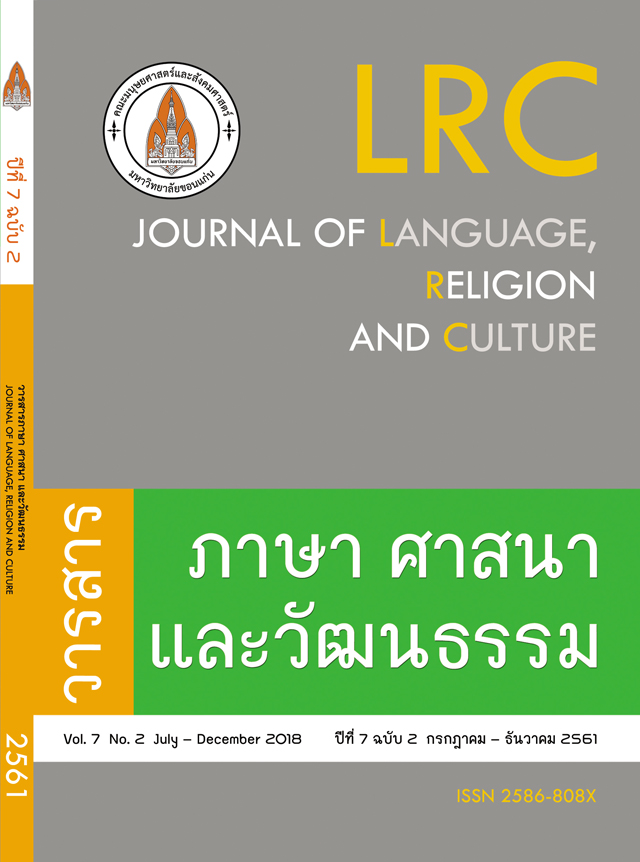เศรษฐศาสตร์นีโอคลาสสิคประยุกต์กับวิถีชาวพุทธเพื่อความสำเร็จทางเศรษฐกิจ ; Neoclassical Economics applied to Buddhist’s Way of Life to Achieve Economic Success
Keywords:
เศรษฐศาสตร์นีโอคลาสสิค, วัฏจักรชีวิต, การออม, เศรษฐศาสตร์เชิงพุทธ, Neoclassical economics, life-cycle, saving, Buddhist economicsAbstract
บทความทางวิชาการฉบับนี้ มุ่งเน้นที่จะนำเสนอกรอบแนวคิดทางเศรษฐศาสตร์สำนักนีโอคลาสสิค มาประยุกต์เข้ากับการดำเนินชีวิตตามวิถีชาวพุทธ โดยการนำเสนอ จะใช้แบบจำลองวัฏจักรชีวิต (Life-cycle model) และแบบจำลองที่มีช่วงเวลาไม่สิ้นสุด ซึ่งสอดคล้องกับการเวียนว่ายตายเกิดในสังสารวัฏตามกรอบแนวคิดทางพุทธศาสนา โดยแบ่งการวิเคราะห์เป็นระยะสั้นและระยะยาว เพื่อนำเสนอแนวคิดต่างๆ ในแบบจำลอง ในการนำมาประยุกต์ใช้ในการดำเนินชีวิตตามวิถีชาวพุทธอย่างเป็นระบบและมีทิศทางในฐานะพุทธศาสนิกชน และได้สรุปโดยการทบทวนวรรณกรรม เพื่อสนับสนุนว่าความศรัทธาในพุทธศาสนาสามารถนำไปสู่การเจริญเติบโตทางเศรษฐกิจที่ยั่งยืนในที่สุด
Abstract
This academic paper is to relate some concepts from Neoclassical economics to apply to Buddhist’s way of life. The paper uses a life-cycle and infinite horizon model, which correspond to transmigration in Buddhism. The analysis is explained in a short-run and a long-run. The discussion presents the ideas from these models to implement in Buddhism so that one can live systematically as a cautious Buddhist laymen. The paper relates many connected literatures to support the fact that stronger belief in Buddhism can eventually promote sustainable economic growth.
References
[2] Azzi, Corry, and Ronald Ehrenberg (1975). Household allocation of time and church attendance. Journal of Political Economy 83.1: 27-56.
[3] Bellman, Richard (1957). Dynamic Programming. Princeton, N.J. Princeton University Press.
[4] Blomberg, S. Brock, Thomas DeLeire, and Gregory D. Hess. (2006). The (after) life-cycle theory of religious contributions. Cesifo Working Paper No. 1854
[5] Bhongmakapat, Teerana (2011). Economics of Enoughness. Pillar of the Kingdom Public Lecture, Chulalongkorn University, February 4.
[6] Cagetti, Marco (2003). Wealth accumulation over the life cycle and precautionary savings. Journal of Business & Economic Statistics 21.3: 339-353.
[7] Chang, Wen-Chun (2005). Religious giving, non-religious giving, and after-life consumption. The BE Journal of Economic Analysis & Policy 5.1.
[8] Conesa, Juan Carlos, Sagiri Kitao, and Dirk Krueger (2009). Taxing capital? Not a bad idea after all!.American Economic Review 99.1: 25-48.
[9] Conze, Edward (1963). Buddhist saivors. The Saviour God: Comparative Studies in the Concept of Salvation. S.G.F. Brandon, ed. Manchester U.K.: Manchester University Press.
[10] Hrung, Warren B. (2004). After-life consumption and charitable giving. American Journal of Economics and Sociology 63.3: 731-745.
[11] Imam, Patrick, and Kangni Kpodar. (2016) Islamic banking: Good for growth?. Economic Modelling 59: 387-401.
[12] Keyes, Charles F.(1983). Merit-transference in the kammic theory of popular Theravada Buddhism. Karma: An anthropological inquiry: 261-286.
[13] Kumru, Cagri S., and Saran Sarntisart (2016). Banking for those unwilling to bank: Implications of Islamic banking systems. Economic Modelling 54: 1-12.
[14] Lambarraa, Fatima, and Gerhard Riener (2012). On the norms of charitable giving in Islam: a field experiment. No. 59. DICE Discussion Paper.
[15] McCleary, Rachel M. (2007). Salvation, damnation, and economic incentives. Journal of Contemporary Religion, 22(1), 49-74.
[16] McCleary, Rachel. M., and Robert J. Barro. (2006). Religion and economy. Journal of Economic perspectives, 20(2), 49-72.
[17] Michel, Philippe, Emmanuel Thibault, and Jean-Pierre Vidal (2006). Intergenerational altruism and neoclassical growth models. Handbook of the economics of giving, altruism and reciprocity 2 (2006): 1055-1106.
[18] Ríos-Rull, José-Víctor (1995). Models with heterogeneous agents. Frontiers of business cycle research: 98-125.
[19] Schumacher, Ernst Friedrich (1973). Small is Beautiful: A Study of Economics as if People Mattered. New Delhi: The Radical Humanist.
[20] Zsolnai, László, ed. (2011). Ethical Principles and Economic Transformation-A Buddhist Approach. Vol. 33. Springer Science & Business Media, 2011.
[21] Leviticus 18:26. https://www.biblestudytools.com/numbers/18.html
[22] พระไตรปิฎก เล่มที่ 15 พระสุตตันตปิฎก เล่มที่ 7 สังยุตตนิกาย สคาถวรรค ปิยสูตรที่ 4 [336]
https://www.84000.org/tipitaka/read/v.php?B=15&A=2269&Z=2315
[23] พระไตรปิฎก เล่มที่ 16 พระสุตตันตปิฎก เล่มที่ 8 สังยุตตนิกาย นิทานวรรค อนมตัคคสังยุตต์ ปฐมวรรคที่ 1 ติณกัฏฐสูตร [421]
https://www.84000.org/tipitaka/attha/v.php?B=16&A=4730&Z=5111
[24] พระไตรปิฎกเล่มที่ 20 พระสุตตันตปิฎก เล่มที่ 12 อังคุตตรนิกาย เอก-ทุก-ติกนิบาต โลณกสูตร [540]
https://www.84000.org/tipitaka/read/v.php?B=20&A=6566&Z=6646
[25] พระไตรปิฎก เล่มที่ 21 พระสุตตันตปิฎก เล่มที่ 13 อังคุตตรนิกาย จตุกกนิบาต อจินติตสูตร
https://www.84000.org/tipitaka/_mcu/v.php?B=21&A=2166&Z=2173
[26] พระไตรปิฎก เล่มที่ 24 พระสุตตันตปิฎก เล่มที่ 16 อังคุตตรนิกาย ทสก-เอกาทสกนิบาต เวรสูตร
https://www.84000.org/tipitaka/read/v.php?B=24&A=4182&Z=4239
[27] พระไตรปิฎก เล่มที่ 26 พระสุตตันตปิฎก เล่มที่ 18 ขุททกนิกาย วิมาน-เปตวัตถุ เถร-เถรีคาถา โคตมเถรคาถา [320]
https://www.84000.org/tipitaka/read/v.php?B=26&A=6159&Z=6168
[28] พระไตรปิฎก เล่มที่ 28 พระสุตตันตปิฎก เล่มที่ 20 ขุททกนิกาย ชาดก ภาค 2 มหานิบาตชาดก เตมิยชาดก [417]
https://www.84000.org/tipitaka/atita/s.php?B=28&A=2607&Z=2870
[29] อรรถกถา อังคุตตรนิกาย เอกนิบาต เอตทัคคบาลี วรรคที่ 7 อรรถกถาสูตรที่ 2
https://www.84000.org/tipitaka/attha/attha.php?b=20&i=152&p=2
[30] อรรถกถา ขุททกนิกาย คาถาธรรมบท มลวรรคที่ 18
https://www.84000.org/tipitaka/attha/attha.php?b=25&i=28&p=3
[31] พจนานุกรมพุทธศาสตร์ ฉบับประมวลธรรม พระพรหมคุณาภรณ์ (ป.อ. ปยุตฺโต)
https://www.84000.org/tipitaka/dic/d_item.php?i=351
[32] กนกศักดิ์ แก้วเทพ (2549). เศรษฐศาสตร์ "บุญนิยม". เศรษฐศาสตร์ธรรมิกราชา. โรงพิมพ์จุฬาลงกรณ์มหาวิทยาลัย มกราคม 2550.
[33] พระครูศรีปรียัติคุณาภรณ์ (2558). แนวคิดทางเศรษฐศาสตร์ในหลักพุทธศาสตร์. มหาวิทยาลัยมหามกุฏราชวิทยาลัย.
https://www.src.mbu.ac.th/images/stories/pdf/007.pdf
[34] พระอธิการทัศเทพ ฐานกโร (2559). พุทธธรรมกับการแก้ปัญหาความยากจนในสังคมไทย. วารสาร มจร พุทธปัญญาปริทรรศน์ ปีที่ 1 ฉบับที่ 3 (กันยายน – ธันวาคม)
[35] อภิชัย พันธเสน (2554). จากความมั่งคั่งถึงความเป็นอยู่ที่ดีและนิพพานในที่สุด: การพัฒนาจิตที่พ้นไปจากวิชาเศรษฐศาสตร์ที่เป็นอยู่ไปสู่พุทธเศรษฐศาสตร์. การบรรยายพิเศษชุดเศรษฐศาสตร์เสวนา คณะเศรษฐศาสตร์ จุฬาลงกรณ์มหาวิทยาลัย 25 มกราคม.







